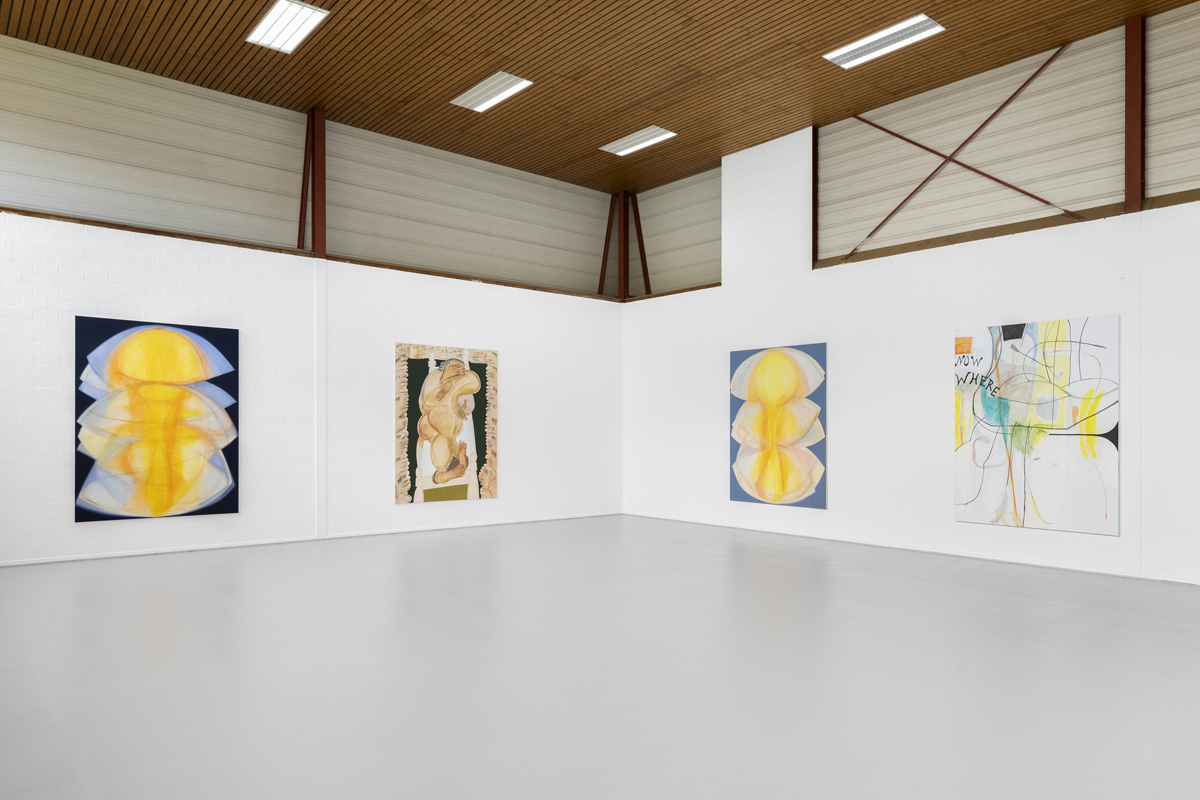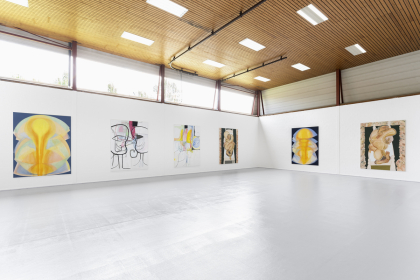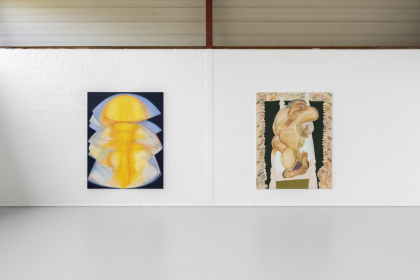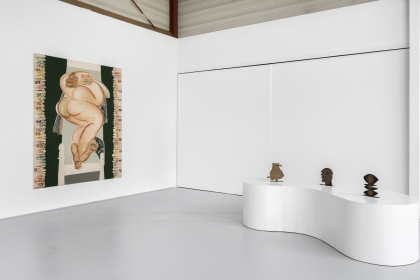
For Third Person, the new exhibition in Whitehouse Gym, Anastasia Bay (1988) invites her fellow artists Julien Saudubray (1985) and Tom Król (1991). Since their meeting at an opening in Brussels in 2016, they have formed a "family" of painters. Connected by shared interests, ideas and views on painting, Bay, Saudubray and Król as a group do not apply a rigid set of rules and dogmas, but start from an idea of generosity and exchange between like-minded artists. For these three young artists, it is all about the pleasure of creating and painting, for themselves but also for the viewer. In doing so, they build on their academic training and their knowledge of art history, but claim a kind of freedom. They choose for themselves what they use and what they renounce. They each seek out and attempt to push the boundaries of painting.
The exhibition at Whitehouse Gym shows how Bay, Saudubray and Król transcend themselves as painters. In addition to the challenge offered by the new very large formats, they seek refuge in a different discipline. For the first time, they are each showing a bronze bas-relief.
The title of the exhibition, Third Person, refers to the idea in painting of the existence of a third neutral party, who, by creating distance between the painter and the work of art, helps to shape the latter. This third body can take all kinds of forms, from a person to a period of time to a space. The gap thus created changes the artist's perception of his/her work. Moreover, it means a change in his/her role from painter to spectator. Here, the work takes the space and time to indicate what and where it wants to be.
The exhibited paintings of Anastasia Bay are inhabited by naked female figures. They lie on a bed in disturbing and twisted poses. Where their bodies have been painted with care, their faces are crudely outlined. In this way, they remain unrecognizable and anonymous. Both on the left and the right, Bay paints heads that seem to be peering at the women. They too remain anonymous and lack clear facial characteristics. The plastic and explicit poses of the female nudes transform the viewers into voyeurs. Their bodies attract, but at the same time repel. In this way, Bay's works denounce social voyeurism and the objectification of the female body.
Bay has drawn inspiration for this series from a medieval visual language. She often draws on themes from art history, mythology and popular culture, mixing periods and genres without hesitation or hierarchy. She explores figurative painting and works with familiar scenes from the classical canon. The construction of her paintings in Third Person is reminiscent of the many medieval and renaissance Madonna’s with Child, such as Giotto's Ognissanti Madonna located at the Uffizi Museum in Florence. Bay here replaces Giotto's enthroned and chaste Madonna with a female, explicitly nude body. The traditional angels make way for anonymous faces. The use of the art-historical image tradition of the Madonna and Child shows how Bay manages to bend painting to her will and create her own visual language.
Whereas Bay uses her knowledge of art history and painting and molds it to her will, Julien Saudubray takes a more drastic approach. He breaks with figurative painting. He abstracts and deconstructs his imagery, trying to minimize his subjectivity. He switches off his intention. Thus, Saudubray succeeds in removing the idea of a subject. As a result, he exposes the internal structure of the canvas.
His exhibited three-part series illuminates Saudubray's practice very well. These abstract paintings are the result of a year of experimentation. In doing so, he kept repeating the same random action on canvas, eventually creating a certain shape akin to an eye. This form expands repetitively and infinitely across the canvas in different capacities: large, small, vertical, horizontal. While he first applies his gestures to canvas with gesso and pastel, he then emphasizes shapes and lines with color and oil paint. Yet he does not eliminate flaws. His actions - sweeping, sanding, erasing - are clearly and visibly part of the works. Saudubray leaves all the stages of the process intact and emphasizes them. In doing so, he explores the limits of the canvas, but also of color, material and his own practice.
In comparison to Bay and Saudubray, Tom Król neither breaks definitively with figurative painting, nor does he bend it to his will. In his works for the Third Person, Król achieves a play between figuration and abstraction, approaching the former in a freer way. Król sees the inclusion of figurative forms in his paintings as a concession to the viewer. The images and texts that the artist derives from his surroundings offer the viewer points of reference. The recognizable painted eye and face, together with the readable words "where now", provide a handhold. This way, the viewer does not lose himself completely in the painting.
The interplay between figuration and abstraction results in a series of works that explore and illuminate various possible approaches to painting. The canvases, built up through layers and free gestures, each show two faces. But where the figures are clearly outlined on one, their contours increasingly lose their sharpness on the other two works. On one of the two more abstract canvases, the faces are almost impossible to identify. Króls' three-part series demonstrates a development from a rather figurative to a totally free approach to painting. In Third Person, Król guides the viewer along the possibilities of the art of painting.
For this group exhibition, Bay, Saudubray and Król are making an excursion into sculpture. For the first time, the three artists are each creating a work in bronze. They approach this material in the same way as the canvas. Layer by layer, they scrape away material or add elements. This creates depth in the surface and gives their works form. Their bas-reliefs literally bring their pictorial world from the canvas into the exhibition space.
The Third Person guides the spectator into the universe of Bay, Saudubray and Król and introduces them to the way in which these three young artists succeed in giving painting new impetus.
Astrid Goubert





